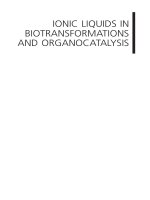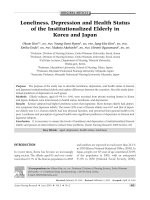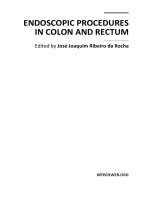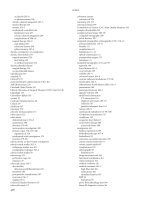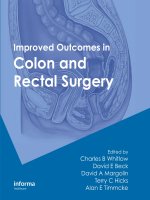ENDOSCOPIC PROCEDURES IN COLON AND RECTUM pptx
Bạn đang xem bản rút gọn của tài liệu. Xem và tải ngay bản đầy đủ của tài liệu tại đây (11.6 MB, 164 trang )
ENDOSCOPIC PROCEDURES
IN COLON AND RECTUM
Edited by José Joaquim Ribeiro da Rocha
Endoscopic Procedures in Colon and Rectum
Edited by José Joaquim Ribeiro da Rocha
Published by InTech
Janeza Trdine 9, 51000 Rijeka, Croatia
Copyright © 2011 InTech
All chapters are Open Access distributed under the Creative Commons Attribution 3.0
license, which permits to copy, distribute, transmit, and adapt the work in any medium,
so long as the original work is properly cited. After this work has been published by
InTech, authors have the right to republish it, in whole or part, in any publication of
which they are the author, and to make other personal use of the work. Any republication,
referencing or personal use of the work must explicitly identify the original source.
As for readers, this license allows users to download, copy and build upon published
chapters even for commercial purposes, as long as the author and publisher are properly
credited, which ensures maximum dissemination and a wider impact of our publications.
Notice
Statements and opinions expressed in the chapters are these of the individual contributors
and not necessarily those of the editors or publisher. No responsibility is accepted for the
accuracy of information contained in the published chapters. The publisher assumes no
responsibility for any damage or injury to persons or property arising out of the use of any
materials, instructions, methods or ideas contained in the book.
Publishing Process Manager Igor Babic
Technical Editor Teodora Smiljanic
Cover Designer Jan Hyrat
Image Copyright prudkov, 2011. Used under license from Shutterstock.com
First published October, 2011
Printed in Croatia
A free online edition of this book is available at www.intechopen.com
Additional hard copies can be obtained from
Endoscopic Procedures in Colon and Rectum, Edited by José Joaquim Ribeiro da Rocha
p. cm.
ISBN 978-953-307-677-5
free online editions of InTech
Books and Journals can be found at
www.intechopen.com
Contents
Preface VII
Chapter 1 Screening and Surveillance Colonoscopy 1
Miroslav Zavoral, Stepan Suchanek, Ondrej Majek,
Barbora Rotnaglova and Jan Martinek
Chapter 2 Preparing for Colonoscopy 17
Parakkal Deepak, Humberto Sifuentes,
Muhammed Sherid and Eli D.Ehrenpreis
Chapter 3 Optimal Bowel Preparation for Colonoscopy 43
Sansrita Nepal, Ashish Atreja and Bret A Lashner
Chapter 4 Monitoring During Colonoscopy 59
Rosalinda S. Hulse
Chapter 5 The Diagnostic Value of Colonoscopy
in Understanding Inflammatory Mucosal Damage
in Patients with Ulcerative Colitis and Predicting
Clinical Response to Adsorptive Leucocytapheresis
as a Non-Pharmacologic Treatment Intervention 81
Tomotaka Tanaka, Abbi R Saniabadi and Yasuo Suzuki
Chapter 6 Virtual Colonoscopy: Indications, Techniques, Findings 95
Mutlu Saglam and Fatih Ors
Chapter 7 Emergency Total Intraoperative
Enteroscopy Using a Colonoscope 109
Francisco Pérez-Roldán, Pedro González-Carro
and María Concepción Villafáñez-García
Chapter 8 Transanal Endoscopic Operation - A New Proposal 117
José Joaquim Ribeiro da Rocha and Omar Féres
Chapter 9 Diagnosis and Endoscopic Treatments of Rectal Varices 145
Takahiro Sato, Katsu Yamazaki and Jun Akaike
Preface
Coloproctology has made tremendous progress, asserting itself as a specialty, it has
been taught in all medical schools and chosen by many as an option in their careers.
There are numerous textbooks that discuss in detail the various issues of
Coloproctology. In this age of computers and virtual reality, when the knowledge they
accumulate and recycle increases each day dramatically, one would be able to question
the decision to make another book on this subject.
When I was invited to edit this publication, I felt as a challenge to review and compile
the chapters presented in this work and make it appropriate and useful to those who
will consult it.
The chapters of screening and surveillance, preparation, monitoring and
considerations about intestinal inflammation through colonoscopy, lead us to current
knowledge and accurate guidance in the improvement of those who already performs
colonoscopies and those who wish to develop research or improve clinical
performance.
The studies of virtual colonoscopy, intraoperative enteroscopy, transanal endoscopic
operations and the treatment of rectal varices show the quality of the experts in
diagnosing and treating ailments with accuracy, the lessons that challenge the
knowledge and the technical skills possessed by the endoscopists and surgeons of
today.
It is a different book, nice and easy to read. Its nine chapters were written by authors
from many different countries, are well designed and they exhaust the subject within
their themes. I am extremely honored to preface and edit this book and I congratulate
all the authors on their work.
José Joaquim Ribeiro da Rocha
Division of Coloproctology of the Department of Surgery and Anatomy,
Ribeirão Preto Faculty of Medicine – University of São Paulo
Brazil
X Preface
1
Screening and Surveillance Colonoscopy
Miroslav Zavoral
1
, Stepan Suchanek
1
, Ondrej Majek
2
,
Barbora Rotnaglova
1
and Jan Martinek
1
1
Charles University, 1
st
Medical Faculty, Central Military Hospital,
Department of Medicine, Prague
2
Masaryk University, Institute of Biostatistics and Analyses, Brno
Czech Republic
1. Introduction
Colorectal cancer (CRC) is the second most frequent malignant disease in Europe. Every year,
412,000 people are diagnosed with this condition, and 207,000 patients die of it. Secondary
prevention of CRC consists of early diagnosis of the disease in asymptomatic individuals
(screening) and long term follow up of high risk patients (surveillance). Three groups of
screening methods are currently available: stool testing (guaiac or immunochemical fecal
occult blood tests – gFOBT and FIT respectively and DNA tests), endoscopic examinations
(flexible sigmoidoscopy and colonoscopy) and radiologic examinations (computed
tomographic colonography and double contrast barium enema). Colonoscopy is therefore
used as the only screening method or as a second step in case of positive results of primary
screening examination (two steps screening programs). From 27 countries in the European
Union, the most frequently used test is FOBT (in 11 states). There is a choice between FOBT
and colonoscopy in 6 countries. FOBT and flexible sigmoidoscopy is available in Italy.
Currently, the only country using colonoscopy as the only screening method is Poland. At the
end of 2010, the European guidelines for quality assurance in colorectal cancer screening and
diagnosis were published, summarizing the evidence based medicine data for the efficacy, the
interval, the age range, the risk-benefit and cost-effectiveness of colonoscopy screening.
Unfortunately, prospective randomized trial on the effect of screening colonoscopy in the
reduction of CRC incidence and mortality has not been published yet. Promising should be the
NordICC study, which was introduced in 2009, however the results will be available in a
fifteen year period. Series of recently published studies (Canada, Germany, Poland) focusing
on the interval (post-colonoscopic) cancers confirmed the inadequate protection of proximal
colon by colonoscopy. Another important issue would be the quality and safety of
colonoscopy and the bowel cleansing. Concerning the surveillance colonoscopy, it plays a
major role in specific follow up strategies in CRC high risk groups. It can be concluded that
with some limitations, colonoscopy still remains the fundamental diagnostic and prophylactic
examination in colorectal cancer screening and surveillance.
2. Colorectal cancer epidemiology in Europe
Colorectal cancer is the second most frequent malignant disease in developed countries.
CRC incidence is generally higher in male population, and the risk of the disease increases
Endoscopic Procedures in Colon and Rectum
2
with age, as the majority of cases are diagnosed in patients over 50 years of age (Spann et
al., 2002). Burden of European countries is ranked as the highest in the global statistics,
both in incidence and mortality. Compared to the US, in 1998 – 2002 the European
population showed a similar incidence for men, while that for women was slightly lower;
the incidence in the USA for men and women was 38.6 and 28.3 respectively: in Europe it
was 38.5 and 24.6 (ASR-W), as calculated per 100,000 inhabitants (Curado et al., 2007) .
However, mortality over the same period of time was significantly higher in Europe than
in the US, both for men and women: in the USA the figures were 13.5 and 9.2 respectively,
while in Europe they were 18.5 and 10.7 (ASR-W), as calculated per 100,000 inhabitants
(World Health Organization [WHO], 2006). To document the situation in Europe, we used
figures available from the international studies summarizing global and European
epidemiologic data (Curado et al., 2007; Ferlay et al., 2004, 2007; Parkin et al., 2005). A
detailed comparison of countries within Europe using the global age standardization
(ASR-W) of incidence is presented in figure 1.
Fig. 1. International comparison of CRC incidence in European countries
Colorectal cancer comprises 12.9% of all newly-diagnosed carcinomas in the European
population (men 12.8%, women 13.1%) and account for 12.2% of deaths caused by
malignancy. Colorectal cancer is the second most common malignancy, after breast
carcinoma (13.5% of all malignities), followed by bronchogenic carcinoma (12.1% of all
malignancies). Every year 412,900 people are diagnosed with CRC in Europe, and 207,400 of
them die of the disease (Ferlay et al., 2007). The average incidence has shown a tendency to
rise in recent years, with an annual increment 0.5%. Data available regarding time trends of
CRC mortality are displayed in figure 2. The CRC-related mortality has stabilized or shown
a slight decrease over recent years.
Screening and Surveillance Colonoscopy
3
Fig. 2. Colorectal cancer mortality trends in Europe (men left, women right)
3. Colorectal cancer prevention
Colorectal cancer belongs to preventable cancers. Primary prevention focuses on dietary and
lifestyle recommendations. Secondary prevention of CRC consists of early diagnosis of the
disease in asymptomatic individuals (screening) in patients older than 50 years of age and a
long term follow up of high risk patients (surveillance).
4. Colorectal cancer screening
Three groups of screening methods are currently available (see in the table below): stool
testing (guaiac or immunochemical fecal occult blood tests – gFOBT and FIT respectively
and DNA tests), endoscopic examinations (flexible sigmoidoscopy and colonoscopy) and
radiologic examinations (computed tomographic colonography and double contrast barium
enema). Colonoscopy is therefore used as the only screening method or as a second step in
case of positive results of primary screening examination (Zavoral et al, 2009).
Type of method Method
Stool tests
for presence of occult blood
guaiac-based (gFOBT)
immunochemical (FIT)
for presence of abnormal DNA
Endoscopic examinations
Radiologic examinations
flexible sigmoideoscopy (FS)
colonoscopy
computed tomographic colonography (CTC)
double contrast barium enema (DCBE)
Table 1. Overview of CRC screening methods
Endoscopic Procedures in Colon and Rectum
4
In 2008, the Report on the Implementation of the Council Recommendation on Cancer
Screening, which provides the most comprehensive data available, was published (Karsa et
al., 2008). According to this report, CRC screening is running or being established in 19 of 27
EU countries. The target group contains approximately 136 million individuals suitable for
CRC screening (aged 50 to 74 years). Of this number, 43% individuals come from 12
countries where CRC population screening is performed or being prepared on either
national or regional levels; 34% come from 5 countries where national population screening
has been implemented (Finland, France, Italy, Poland, and United Kingdom). In 7 EU
countries, national non-population based screening is carried out, which covers 27% of the
target population. In 2007, gFOBT (which was the only test recommended by the Council of
the European Union in 2003) was used as the only screening method in twelve countries
(Bulgaria, Czech Republic, Finland, France, Hungary, Latvia, Portugal, Romania, Slovenia,
Spain, Sweden, and United Kingdom). Colonoscopy was the only screening method used in
Poland. In six countries, two types of tests were used: iFOBT and FS in Italy, and gFOBT and
colonoscopy in Austria, Cyprus, Germany, Greece, and Slovak Republic. In the remaining
eight states (Belgium, Denmark, Estonia, Ireland, Lithuania, Luxembourg, Malta, and the
Netherlands), CRC screening has not been implemented yet. The age limit for the target
population varies across the EU countries. In 2007, it was estimated that a total of 12 million
individuals participated in CRC screening.
4.1 Selected colonoscopy CRC screening programs
Poland is currently the only state using colonoscopy as the only screening method, without
the alternative of FOBT. An opportunistic screening programme was initiated in 2000, and
by now, this had grown to 80 centers across the whole of Poland. The programme is
financed by the Ministry of Health, independentantly from the overall healthcare system.
The target population (asymptomatic individuals aged 55–66 years) is recruited through
general practitioners. High emphasis is placed on the quality control of colonoscopies, with
complications reported for 0.1% procedures, and no patient dying. The advantage of the
programme consists in thorough monitoring and evaluation, including monitoring of
interval cancers (Regula et al., 2006).
Germany was the first country to introduce a population screening programme (in 1976)
based on an annual gFOBT for individuals older than 44 years of age. Starting in 2002, the
participants were offered a choice between colonoscopy at 55 years of age (in a ten-year
interval) and FOBT in annual intervals between 50 and 54 years of age and in a two-year
interval after 55 years of age. In case of FOBT positivity, screening colonoscopy followed.
Between 2003 – 2008, there were 2 821 392 colonoscopies performed in over 2 100 practices
all over Germany. The cumulative participation rate was 17.2% for women and 15.5% for
men. Adenomas were diagnosed in a total of 19.4%, advanced adenomas in 6.4% and
carcinomas in 0.9% of the examined patients. The majority of cancers were in early stage
(UICC 47.3%, UICC II 22.3%, UICC III 20.7%, and UICC IV 9.6%). The overall and serious
complication rate was 2.8 and 0.58 respectively per 1 000 colonoscopies. The cost analyses
have proven the cost effectiveness of such screening (Pox et al., 2007).
In the Czech Republic, CRC screening has many years of tradition. It was the second
country in the world to start a nation-wide screening programme (in 2000), based on
biennial gFOBT offered to asymptomatic individuals older than 50 years of age. In order to
achieve higher compliance rate, screening colonoscopy was added to current FOBT
Screening and Surveillance Colonoscopy
5
screening as an alternative method in 2009, in the same intervals as in the German
programme. Both, gFOBT and various types of FIT are offered as well. During years 2006 –
2010, there were 47 760 screening colonoscopies (FOBT+) and 5 574 primary screening
colonoscopies performed. Adenomas and carcinomas were diagnosed in 16 454 (30.9%) and
2 539 (4.8%) respectively. The proportion of advanced adenomas and generalized cancer
(UICC stage III and IV) was 48% and 20.7% respectively (Zavoral et al., 2009).
4.2 Screening colonoscopy studies
The multinational NordICC (The Nordic-European Initiative on Colorectal Cancer) study
was introduced in June 2009, however the results will be available in a fifteen year period.
This study focuses on monitoring the effect of colonoscopy screening on reducing CRC
incidence and mortality. The northern states of Europe (Norway, Sweden, and Iceland),
Poland, and the Netherlands all participate. The Czech Republic, Hungary and Latvia are
currently observers and may join the study later. According to the study protocol, a
minimum of 66,000 individuals aged 55 to 64 years will be drawn directly from population
registers in the participating countries and randomly assigned to either once-only
colonoscopy screening or no screening (2:1 randomization, men and women). The primary
objective is to compare the incidence and mortality against the control group after 15 years.
At this time, more than 5 500 individuals have been examined so far and the recruitment
will continue until the end of 2012 (NordiCC Study Protocol, 2011).
CONFIRM (Colonoscopy vs. Fecal Immunochemical Test Reducing Mortality from
Colorectal Cancer), the VA Cooperative study, is a multicenter, randomized, parallel group
trial directly comparing screening colonoscopy with annual FIT screening in average risk
individuals. The quantitative FIT (OC Sensor Diana) cut-off will be set at 100 ng/ml. The
primary endpoint expected is CRC mortality reduction by 40% within a 10 year enrolment.
The planned study duration is 12.5 years with 2.5 years of recruitment of 50 000 participants
(1:1 randomization, 95% men, aged 50 – 75) and 2.5 years of follow-up for enrolled
participants (Dominitz et al., 2011).
COLONPREV (Colorectal Cancer Screening in Average-Risk Population: a Multicenter,
Randomized Controlled Trial Comparing Immunochemical Fecal Occult Blood Testing
versus Colonoscopy) study is being carried out since November 2008 in eight Spanish
regions under the coordination of the public health system, primary care physicians and
tertiary academic medical centers. Asymptomatic individuals aged 50 – 69 years have been
randomized into two groups (1:1). Biennial quantitative FIT (OC Sensor, cut-off level 75
ng/ml), followed by colonoscopy in case of its positivity has been offered to one group and
colonoscopy to the second group. First preliminary results are expected in June 2011
(Castellas et al., 2011)
The Japan Polyp Study (JPS) is a multicenter randomized control trial focusing on
postpolypectomy surveillance and conducted in eleven centers since February 2003. Two
complete colonoscopies with the removal of all neoplastic lesions (to reach “clean colon”)
have been performed to the enrolled patients who have been randomized into two groups
(1:1) afterwards, according to the colonoscopy follow-up interval. One group underwent a
colonoscopy after 48 months, the second group at 24 and 48 months. From a total of 4 752
individuals, 3 926 (83%) agreed with the initial colonoscopy and 2 757 (58%) patients were
randomized. There has been a great impact on polyp distribution and macroscopic type in
the first two initial colonoscopies. Very high adenoma detection (63%) was reached
(Matsuda, 2011).
Endoscopic Procedures in Colon and Rectum
6
4.3 Screening colonoscopy characteristics
At the end of 2010, the European guidelines for quality assurance in colorectal cancer
screening and diagnosis were published, summarizing the evidence based medicine data for
the efficacy, the interval, the age range, the risk-benefit and cost-effectiveness of colorectal
cancer screening, including sigmoidoscopy (FS) and colonoscopy screening analysis.
4.3.1 Evidence for effectiveness of sigmoidoscopy screening
Flexible sigmoidoscopy screening reduces colorectal cancer (CRC) incidence and mortality if
performed in an organised screening programme with careful monitoring of the quality and
systematic evaluation of the outcomes, adverse effects and costs (Atkin et al., 2010). The
evidence on the efficacy is avaible from randomised controlled trials (RCTs). The most
important one is the large UK study in which 57 237 individuals were randomised into the
screening group for a once-only sigmoidoscopy alone. This study found a significant 31%
reduction in CRC mortality and also a significant reduction in CRC incidence from
sigmoidoscopy in an intention-to-treat analysis (Atkin et al., 2010).
The optimal interval for sigmoidoscopy screening was only assessed in two indirect studies
that only considered intervals of three and five years (Platell et al., 2002, Schoen et al., 2003).
The UK flexible sigmoidoscopy screening study showed that there was little attenuation of
the protective effect of sigmoidoscopy after 11 years of follow-up. This is in line with the
evidence for colonoscopy screening. In conclusion, the optimal interval for endoscopy
screening should not be less than 10 years and may even be extended to 20 years (Atkin et
al., 2010).
There is limited evidence suggesting that the best age range for flexible sigmoidoscopy
screening should be between 55 and 64 years (Segnan et al., 2007). One study
demonstrated that elderly subjects (75 years old) have an increased rate of endoscopist-
reported difficulties and a higher rate of incomplete examinations compared to subjects
aged 50–74 years (Pabby et al, 2005). Average-risk sigmoidoscopy screening should be
discontinued after 74 years of age, given the increasing co-morbidity in this age range
(Atkin et al., 2010).
4.3.2 Evidence for effectiveness of colonoscopy screening
Limited evidence exists on the efficacy of colonoscopy screening on CRC incidence and
mortality (Atkin et al, 2010). However, two recent case–control studies found a significant
reduction of 31% in CRC mortality (Baxter et al., 2009) and 48% in advanced neoplasia
detection rates (Brenner et al., 2010). The reduction in these studies was limited to the
rectum and left side of the colon. No significant reduction was found in right-sided disease.
Cross-sectional surveys have shown that colonoscopy is more sensitive than sigmoidoscopy
in detecting adenomas and cancers and that this increased sensitivity could translate into
increased effectiveness (Walsh et al., 2003). The efficacy of colonoscopy as a primary
screening test has not been proven by prospective randomized control trial.
The optimal interval for colonoscopy screening has been assessed in a cohort study and a
case-control study. The cohort study found that CRC incidence in a population with
negative colonoscopy was 31% lower than general population rates and remained reduced
beyond 10 years after the negative colonoscopy (Singh et al., 2006). Similar results were
obtained in the case–control study (Brenner et al., 2006) where the reduction of risk of CRC
was 74 % and persisted up to 20 years.
Screening and Surveillance Colonoscopy
7
Screening colonoscopies do not need to be performed at intervals shorter than 10 years and
this time interval may even be extended to 20 years (Atkin et al., 2010).
There is no direct evidence confirming the optimal age range for colonoscopy screening.
Indirect evidence suggests that the prevalence of neoplastic lesions in the younger
population (less than 50 years) is too low to justify colonoscopic screening, while in the
elderly population (more than 75 years) the lack of benefit could be a major issue (Pabby et
al., 2005). The optimal age for a single colonoscopy appears to be around 55 years. Average
risk colonoscopy screening should not be performed before age 50 and should be
discontinued after 74 years of age (Atkin et al., 2010).
5. Colonoscopic surveillance following adenoma removal
The adenomatous polyp is the precursor of most colorectal cancers and is the most
frequently detected lesion during a colonoscopy examination (Lieberman et al., 2000).
Hyperplastic polyps, on the other hand, usually have no clinical significance. Based on the
statistics, in 33 % – 50 % of patients consecutive adenomas develop within three years after
the removal of first adenoma. In addition, in 0,3-0,9 % of cases colorectal carcinoma is
detected within five years (Alberts et al., 2000; Arber et al., 2006; Baron et al., 2006; Martinez
et al., 2009; Robertson et al., 2005). Most of these adenomas and malignancies are, however,
represented by lesions missed during the first colonoscopy. The quality of a colonoscopic
examination must therefore be emphasized. Medical centers involved in screening
programmes thus often undergo quality controls. One of the key aims of a surveillance
colonoscopy is to detect all new lesions or lesions that have been missed at baseline
colonoscopy before they progress to malignancy. The other aim of a follow-up colonoscopy
is the detection of colorectal carcinoma at an early, prognostically more favorable stage
(Robertson et al., 2005).
Picture 1. Sessile polyp - white light
Endoscopic Procedures in Colon and Rectum
8
Picture 2. Sessile polyp - NBI (narrow band imaging)
Picture 3. Sessile polyp - Patent Blue injection
Screening and Surveillance Colonoscopy
9
Picture 4. Postpolypectomy site
Colonoscopy is an invasive method with a small, however not insignificant risk of possible
complications, amongst which are perforation (0,06 % diagnostic and 2 % therapeutical
colonoscopies) and hemorrhage after polypectomy (02,-2,7 % according to size of lesion)
(Rosen et al., 1993). Surveillance colonoscopies represent a burden for endoscopic centers
prolonging the waiting lists. For these reasons, surveillance colonoscopies should be carried
out in recommended intervals in order to prevent the development of colorectal carcinoma.
The malignant potential of an adenoma depends on its size, histological verification and the
grade of dysplasia. It is higher in advanced adenomas (larger than 10 mm or more, with a
villous component or a high grade dysplasia). Recent studies show, that the villous
component is a less significant predictor for the development of malignancy than the
remaining two factors.
5.1 Risk factors for advanced adenomas and colorectal cancer after baseline
polypectomy
The risk of detection of advanced adenoma or carcinoma during a surveillance colonoscopy
depends on the quality of the first (baseline) colonoscopy and the characteristics of the
removed polyp.
It is generally agreed that high quality colonoscopies carried out less frequently are more
efficient in the prevention of colorectal cancer than more frequent colonoscopies of a lower
quality. Colonoscopy examination should only be carried out after adequate bowel
preparation in order to properly visualize bowel mucosa. Patients with poor bowel
preparation have to be invited for a repeated colonoscopy, considering the colonoscopy was
well indicated in the first place. The examination must also be complete (reaching the
caecum) and the withdrawal of an endoscope should be slow and careful. All detected
lesions have to be removed carefully, ideally as hoc during their detection since they can
Endoscopic Procedures in Colon and Rectum
10
easily be overlooked during the next examination. Polyp removal must be done during the
withdrawal of a scope due to the possible risk of bleeding and perforation.
Based on the following meta-analysis (Saini et al., 2006) it is obvious that a personal history
of 3 adenomatous polyps increases the risk for the presence of advanced adenoma 2x,
whereas the history of five polyps increases the risk at a surveillance colonoscopy 4x, as
opposed to the detection of a single polyp during a baseline colonoscopy. The polyp size
also plays a significant role. The real size is considered to be the size of the histological
specimen measured by a pathologist. In case a piece-meal polypectomy is performed, the
size is based upon the judgment of the endoscopist (comparing the lesion with a known size
of biopsy forceps). Adenomas measuring between 10 to 20 mm have twice the increased
risk, adenomas measuring 20 mm or more have 3x the increased risk of turning to
malignancy as opposed to small adenomas (up to 10mm) (Cafferty et al., 2007).
Adenoma histology does not play as significant role as believed earlier. However, a villous
structure polyp increases the chance of villous adenoma detection during a surveillance
colonoscopy (Cafferty et al., 2007). On the other hand, the presence of high grade dysplasia
significantly increases the risk of malignant changes in adenomas of varying size (Saini et
al., 2006).
Based on the studies listed below, the localization of polyp in the right colon increases the
risk of advanced colorectal neoplasia 1,5-2,5 times as opposed to its localization in the left
colon (Laiyemo et al., 2009; Martinez et al., 2009; Saini et al., 2006)
5.2 Risk factors in patients
One of the risk factors is older age, which correlates with the higher incidence of
advanced colorectal neoplasia, at the same time it is related to an increased difficulty of a
colonoscopy examination and its performance, worse bowel preparation and a higher risk
of complications related to the examination itself. It is always necessary to proceed
individually recognizing all comorbidities of a patient, the benefit of the examination
itself, whilst considering whether the lead time for progression of adenoma to colorectal
cancer does not exceed the life-expectancy of an individual, particularly in patients aged
75 years or older. The upper age boundary for surveillance cessation is usually 75 years of
age. A positive family history for an adenoma, unless a dominant genetic disease is
suspected, does not require any special precautions during surveillance colonoscopies
(Atkin et al., 2010).
5.3 Stratification of risk factors in patients
According to European guidelines for the quality assurance in colorectal cancer screening
and diagnosis (2010), the degree of risk should be determined based on the findings at
baseline colonoscopy. It is recommended to divide patients into groups with low,
intermediate and high risk of colorectal neoplasia development, thus more easily
determining the interval of colonoscopy examinations. Based on these results, further
surveillance can be modified (Atkin et al., 2010).
Low risk group: Patients with one or two polyps measuring up to 10 mm, with tubular
structure and low grade dysplasia are considered to be in low risk of developing colorectal
carcinoma and may further continue in the population screening programme. However, it is
necessary to also consider their age, family history, degree of bowel preparation and the
quality of colonoscopy examinations.
Screening and Surveillance Colonoscopy
11
Intermediate risk group: Patients with three or four small polyps, or one adenomatous
polyp measuring ≥ 10 mm and 20 mm, or a polyp with villous structure or high grade
dysplasia, are considered to be in an intermediate risk group and should have a follow up
colonoscopy in a three year interval. If there is a negative finding during the first
surveillance colonoscopy another examination is indicated 5 years after the previous one.
After two surveillance colonoscopies with a physiological finding, the patient can transfer to
the common population colorectal cancer screening programme. If low or intermediate risk
adenomas are detected, the patient should further be placed in an intermediate risk group
(next surveillance colonoscopy being in a 3 year interval), in high risk polyps the next
colonoscopy is recommended within 1 year.
High risk group: Patients with five small polyps or one polyp measuring at least 20mm or
more are indicated to have a surveillance colonoscopy within one year from their baseline
colonoscopy. If there is a negative finding or an adenoma with intermediate risk is detected,
the next examination is recommended after three years. Two negative controls shift the
interval for another colonoscopy by further 5 years. When a high risk adenoma is detected
during a surveillance colonoscopy, an early examination is necessary – within 1 year. The
aim of an early surveillance examination is to detect concurrent lesions that were not picked
up during a baseline colonoscopy.
5.4 Recommendations for surveillance in chosen colonoscopy findings
Endoscopically removed pT1 carcinoma is considered a high risk lesion based on its
biological characteristics, the first surveillance colonoscopy interval thus being within 12
months from the first one (Chu et al., 2003; Di Gregorio et al., 2005; Rex et al., 2006).
For surveillance purposes, serrated adenomas (i.e., traditional serrated adenomas and mixed
polyps with at least one adenomatous component) should be dealt with using standard
recommendations like any other adenoma. Currently, there is no data available that would
explicitly certify the need for any other surveillance programme.
There has been no proof that a small hyperplastic polyp has an increased risk of colorectal
carcinoma, patients with this finding are therefore placed in standard population screening
programme. Individuals with one or more hyperplastic polyps measuring more than 10mm,
or with non-neoplastic serrated lesions of the colon, or with multiple small lesions in the
right colon, are considered to have a higher risk of developing colorectal neoplasia.
However, accurate recommendations cannot be reliably determined for the current lack of
data (Atkin et al., 2010).
Large sessile lesion removed by a piece-meal resection should be checked within 2-3
months, so that small areas of residual tissue can be treated endoscopically early enough.
Within the next 3 months they can easily be identified using India ink tattooing and ideally
completely eradicated. When a large residual finding is detected during a follow up
examination, further endoscopic or surgical treatment should be considered.
5.5 Stopping surveillance
Stopping surveillance depends on several factors, not only on the characteristics of detected
polyps, but also on age, comorbidities and personal wishes. The upper age boundary for
surveillance colonoscopy is considered to be 75 years or older (Atkin et al., 2010). At this
stage, patients can discontinue the surveillance programme and return to the population
Endoscopic Procedures in Colon and Rectum
12
screening programme. On the other hand, patients undergoing the surveillance programme
being followed up endoscopically are not indicated to continue with the FOBT.
6. Conclusion
Colonoscopy plays a major role in colorectal cancer screening. Recently published
Europeans guidelines showed that although no randomized control study on the efficacy of
colonoscopy has been completed yet, the recent case-control studies found a significant
reduction of 31% CRC mortality. Very promising is the NordICC trial which could confirm
these results. To reduce the appearance of interval cancer, colonoscopy quality control and
adequate bowel preparation is necessary. Colonoscopy can be considered an effective and
safe procedure.
A well organized surveillance programme for patients with adenoma, advanced adenoma
or carcinoma is just as important as a baseline colonoscopy examination with its quality and
precision being the determining factors of the follow up intervals. Patients should be
divided into three categories using simple criteria, depending on the presumed risk of
developing colorectal cancer, while being endoscopically followed up at given intervals. It is
always necessary to take into consideration age, comorbidities, personal and family history,
and the personal wish of each individual.
7. Acknowledgment
Authors would like to thank Dr. Gabriela Veprekova for important contribution and
literature research together with the preparation of the manuscript, and also to assoc. prof.
Ladislav Dusek, MSc., PhD, dr. Jan Muzik, MSc., PhD and dr. Jakub Gregor, PhD for
providing the epidemiology figures.
8. References
Alberts, D.S.; Martinez, M.E.; Roe, D.J.; Guillen-Rodriguez, J.M.; Marshall, J.R.; van
Leeuwen, J.B.; Reid, M.E.; Ritenbaugh, C.; Vargas, P.A.; Bhattacharyya, A.B.;
Earnest, D.L. & Sampliner, R.E. (2000). Lack of effect of a high-fiber cereal
supplement on the recurrence of colorectal adenomas. Phoenix Colon Cancer
Prevention Physicians' Network. N.Engl.J.Med., vol. 342, no. 16, pp. 1156-1162
Arber, N.; Eagle, C.J.; Spicak, J.; Racz, I;, Dite, P.; Hajer, J.; Zavoral, M.; Lechuga, M.J.;
Gerletti, P.; Tang, J.; Rosenstein, R.B.; Macdonald, K.; Bhadra, P.; Fowler, R.; Wittes,
J.; Zauber, A.G.; Solomon, S.D. & Levin, B. (2006). Celecoxib for the prevention of
colorectal adenomatous polyps. N.Engl.J.Med., vol. 355, no. 9, pp. 885-895
Atkin, W.; Valori, R.; Kuipers, E.J.; Hoff, G.; Senore, C.; Segnan N.; Jover, R.; Schmiegel, W.;
Lambert, R. & Pox, C. (2010). Colonoscopic surveillance following adenoma
removal. In: Segnan N, Patnick J, von Karsa L. European guidelines for quality
assurance in colorectal cancer screening and diagnosis, 1st ed., European Union,
2010:274-297, ISBN 978-92-79-16435-4, doi: 10.2772/1458
Atkin, W.S.; Edwards, R.; Kralj-Hans, I.; Wooldrage, K.; Hart, A.R.; Northover, J.M.; Parkin,
D.M.; Wardle, J.; Duffy, S.W. & Cuzick, J. (2010). Once-only flexible sigmoidoscopy
Screening and Surveillance Colonoscopy
13
screening in prevention of colorectal cancer: a multicentre randomised controlled
trial. Lancet, vol. 375, no. 9726, pp. 1624-1633
Baron, J.A.; Sandler, R.S.; Bresalier, R.S.; Quan, H.; Riddell, R.; Lanas, A.; Bolognese, J.A.;
Oxenius, B.; Horgan, K.; Loftus, S. & Morton, D.G. (2006). A randomized trial of
rofecoxib for the chemoprevention of colorectal adenomas. Gastroenterology, vol.
131, no. 6, pp. 1674-1682
Baxter, N.N.; Goldwasser, M.A.; Paszat, L.F.; Saskin, R.; Urbach, D.R. & Rabeneck, L. (2009).
Association of colonoscopy and death from colorectal cancer. Ann.Intern.Med., vol.
150, no. 1, pp. 1-8
Brenner, H.; Hoffmeister, M; Arndt, V.; Stegmaier, C.; Altenhofen, L. & Haug, U. (2010).
Protection from right- and leftsided colorectal neoplasms after colonoscopy:
population-based study. J.Natl.Cancer Inst., vol. 102, no. 2, pp. 89-95
Brenner, H.; Chang-Claude, J.; Seiler, C.M.; Sturmer, T. & Hoffmeister, M. (2006). Does a
negative screening colonoscopy ever need to be repeated? Gut, vol. 55, no. 8, pp.
1145-1150
Cafferty, F.H.; Wong, J.M.; Yen, A.M.; Duffy, S.W.; Atkin, W.S. & Chen, T.H. (2007).
Findings at follow-up endoscopies in subjects with suspected colorectal
abnormalities: effects of baseline findings and time to follow-up. Cancer J, vol. 13,
no. 4, pp. 263-270
Castells, A. & Quintero, E. (2011). Colorectal Cancer Screening in Average-Risk Population:
A Multicenter, Randomized Controlled Trial Comparing Immunochemical Fecal
Occult Blood Testing versus Colonoscopy. WEO/OMED Colorectal Cancer
Screening Committee Meeting. Available at
/>rc11_3_2_5_castells.pdf. Last accessed June, 4, 2011
Chu, D.Z.; Chansky, K.; Alberts, D.S.; Meyskens, F.L. Jr.; Fenoglio-Preiser, C.M.; Rivkin, S.E.;
Mills, G.M.; Giguere, J.K.; Goodman, G.E.; Abbruzzese, J.L. & Lippman, S.M.
(2003). Adenoma recurrences after resection of colorectal carcinoma: results from
the Southwest Oncology Group 9041 calcium chemoprevention pilot study.
Ann.Surg.Oncol, vol. 10, no. 8, pp. 870-875
Curado, M.P.; Edwards, B.; Shin, H.R.; Storm,.H.; Ferlay, J.; Heanue, M. & Boyle, P. (2007).
Cancer Incidence in Five Continents, Vol. IX. IARC Scientific Publications No. 160,
Lyon, IARC. Available at section CI5 IX. Last accessed
June, 4, 2011
Di Gregorio, C.; Benatti, P.; Losi, L.; Roncucci, L.; Rossi, G.; Ponti, G.; Marino, M.; Pedroni,
M.; Scarselli, A.; Roncari, B. & Ponz, L.M. (2005). Incidence and survival of patients
with Dukes' A (stages T1 and T2) colorectal carcinoma: a 15-year population-based
study. Int J Colorectal Dis, vol. 20, no. 2, pp. 147-154
Dominitz, J.A. & Robertson, D.J. (2011). Colonoscopy Versus Fecal Immunochemical Testing
in Reducing Mortality From Colorectal Cancer (CONFIRM). Available at
Last accessed June, 4, 2011
Ferlay, J.; Bray, F. & Pisani, P. GLOBOCAN 2002. Cancer incidence, mortality and
prevalence worldwide. IARC Cancer Base No. 5 version 2.0. IARC press, Lyon
Endoscopic Procedures in Colon and Rectum
14
2004. Available at section GLOBOCAN 2002 Last
accessed June, 4, 2011
Ferlay, J.; Autier, P.; Boniol, M.; Heanue, M.; Colombet, M. & Boyle, P. (2007) Estimates of
the cancer incidence and mortality in Europe in 2006. Ann Oncol. Mar;18(3):581-92.
Epub 2007 Feb 7. PMID: 17287242
Karsa, L. v.; Anttila, A.; Ronco, G.; Ponti, A.; Malila, N.; Arbyn, M.; Segnan, N.; Castillo-
Beltran; M., Boniol; M., Ferlay, J.; Hery, C.; Sauvaget, C.; Voti, L. & Autier, P. (2008).
Cancer screening in the European Union. Report on the implementation of the
Council Recommendation on cancer screening - First Report. ISBN 978-92-79-08934-
3. European Communities (publ.) Printed in Luxembourg by the services of the
European Commission, 2008. Available at
/>ing.pdf. Last accessed June, 4, 2011
Laiyemo, A.O.; Pinsky, P.F.; Marcus, P.M.; Lanza, E.; Cross, A.J.; Schatzkin, A. & Schoen R.E.
(2009). Utilization and yield of surveillance colonoscopy in the continued follow-up
study of the polyp prevention trial. Clin.Gastroenterol.Hepatol., vol. 7, no. 5, pp. 562-
567
Lieberman, D.A.; Weiss, D.G.; Bond, J.H.; Ahnen, D.J.; Garewal, H. & Chejfec, G. (2000). Use
of colonoscopy to screen asymptomatic adults for colorectal cancer. Veterans
Affairs Cooperative Study Group 380. N.Engl.J.Med., vol. 343, no. 3, pp. 162-168
Matsuda, T. Japan Polyp Study: Post-polypectomy RCT- Update. (2011). WEO/OMED
Colorectal Cancer Screening Committee Meeting. Available at
/>rc11_3_1_1_matsuda.pdf. Last accessed June, 4, 2011
Martinez, M.E.; Baron, J.A.; Lieberman, D.A.; Schatzkin, A.; Lanza, E.; Winawer, S.J.; Zauber,
A.G.; Jiang, R.; Ahnen, D.J.; Bond, J.H.; Church, T.R.; Robertson, D.J.; Smith-
Warner, S.A.; Jacobs, E.T.; Alberts, D.S. & Greenberg, E.R. (2009). A pooled analysis
of advanced colorectal neoplasia diagnoses after colonoscopic polypectomy.
Gastroenterology, vol. 136, no. 3, pp.832-841
NordiCC Study Protocol. Version MB 260409. Available at
Last accessed
June, 4, 2011
Parkin, D.M.; Whelan, S.L.; Ferlay, J. & Storm, H. (2005). Cancer Incidence in Five
Continents, Vol. I to VIII. IARC CancerBase No. 7, Lyon. Available at http://www-
dep.iarc.fr/, section CI5 I-VIII. Last accessed June, 4, 2011
Platell, C.F.; Philpott, G. & Olynyk JK (2002). Flexible sigmoidoscopy screening for colorectal
neoplasia in average-risk people: evaluation of a five-year rescreening interval.
Med.J.Aust., vol. 176, no. 8, pp. 371-373
Pabby, A.; Suneja, A.; Heeren, T. & Farraye, F.A. (2005). Flexible sigmoidoscopy for
colorectal cancer screening in the elderly. Dig.Dis Sci., vol. 50, no. 11, pp. 2147-2152
Pox, C.; Schmiegel, W. & Classen M. (2007). Current status of screening colonoscopy in
Europe and in the United States. Endoscopy 2007 Feb;39(2):168-73. PMID: 17327977.
doi:10.1055/s-2007-966182
Screening and Surveillance Colonoscopy
15
Regula, J.; Rupinski, M.; Kraszewska, E.; Polkowski, M.; Pachlewski, J.; Orlowska, J.;
Nowacki, M.P. & Butruk, E. (2006). Colonoscopy in colorectal-cancer screening for
detection of advanced neoplasia. N. Engl J Med 2006 Nov 2;355(18):1863-72.
PMID: 17079760
Rex, D.K.; Kahi, C.J.; Levin, B.; Smith, R.A.; Bond, J.H.; Brooks, D.; Burt, R.W.; Byers, T.;
Fletcher, R.H.; Hyman, N.; Johnson, D.; Kirk, L.; Lieberman, D.A.; Levin, T.R.;
O'Brien, M.J.; Simmang, C.; Thorson, A.G. & Winawer, S.J. (2006). Guidelines for
colonoscopy surveillance after cancer resection: a consensus update by the
American Cancer Society and US Multi-Society Task Force on Colorectal Cancer.
CA Cancer J Clin, vol. 56, no. 3, pp. 160-167
Robertson, D.J.; Greenberg, E.R.; Beach, M.; Sandler, R.S.; Ahnen, D.; Haile, R.W.; Burke,
C.A.; Snover, D.C.; Bresalier, R.S.; Keown-Eyssen, G.; Mandel, J.S.; Bond, J.H.; Van
Stolk, R.U.; Summers, R.W.; Rothstein, R.; Church, T.R.; Cole, B.F.; Byers, T.; Mott,
L. & Baron, J.A. (2005). Colorectal cancer in patients under close colonoscopic
surveillance. Gastroenterology, vol. 129, no. 1, pp. 34-41
Rosen, L.; Bub, D.S.; Reed, J.F., III. & Nastasee, S.A. (1993). Hemorrhage following
colonoscopic polypectomy. Dis.Colon Rectum, vol. 36, no. 12, pp. 1126-1131
Schoen, R.E.; Pinsky, P.F.; Weissfeld, J.L.; Bresalier, R.S.; Church, T.; Prorok, P. & Gohagan,
J.K. (2003). Results of repeat sigmoidoscopy 3 years after a negative examination.
JAMA, vol. 290, no. 1, pp. 41-48
Schoenfeld, P.; Cash, B.; Flood, A.; Dobhan, R.; Eastone, J.; Coyle, W.; Kikendall, J.W.; Kim,
H.M.; Weiss, D.G.; Emory, T.; Schatzkin, A. & Lieberman, D. (2005). Colonoscopic
screening of average-risk women for colorectal neoplasia. N.Engl.J.Med., vol. 352,
no. 20, pp. 2061-2068
Segnan, N.; Senore, C.; Andreoni, B.; Azzoni, A.; Bisanti, L.; Cardelli; A., Castiglione, G.;
Crosta, C.; Ederle, A.; Fantin, A.; Ferrari, A.; Fracchia, M.; Ferrero, F.; Gasperoni, S.;
Recchia, S.; Risio, M.; Rubeca, T.; Saracco, G. & Zappa, M. (2007). Comparing
attendance and detection rate of colonoscopy with sigmoidoscopy and FIT for
colorectal cancer screening. Gastroenterology, vol. 132, no. 7, pp. 2304-2312
Saini, S.D.; Kim, H.M. & Schoenfeld, P. (2006). Incidence of advanced adenomas at
surveillance colonoscopy in patients with a personal history of colon adenomas: a
meta-analysis and systematic review. Gastrointest.Endosc., vol. 64, no. 4, pp. 614-626
Singh, H.; Turner, D.; Xue, L.; Targownik, L.E. & Bernstein, C.N. (2006). Risk of developing
colorectal cancer following a negative colonoscopy examination: evidence for a 10-
year interval between colonoscopies. JAMA, vol. 295, no. 20, pp. 2366-2373
Spann, S.J.; Rozen, P.; Young, G.P. & Levin, B. (2002). Colorectal cancer: how big is the
problem, why prevent it, and how might it present? In: Rozen P, Young GP, Levin
B, Spann SJ. Colorectal Cancer in Clinical Practice. London, England: Martin Dunitz
Ltd; pp: 1-18
Walsh, J.M. & Terdiman, J.P. (2003). Colorectal cancer screening: scientific review. JAMA,
vol. 289, no. 10, pp. 1288-1296
World Health Organization (2006), mortality database, United Nations, World Population
Prospects. Available at
Last accessed June, 4, 2011
Endoscopic Procedures in Colon and Rectum
16
Zavoral, M.; Suchanek, S.; Zavada, F.; Dusek, L.; Muzik, J.; Seifert & B.; Fric, P. (2009).
Colorectal cancer screening in Europe. World Journal Of Gastroenterology,
Vol.15,No.47, (December 2009), pp. 5907-5915, ISSN 1007-9327
2
Preparing for Colonoscopy
Parakkal Deepak, Humberto Sifuentes,
Muhammed Sherid and Eli D.Ehrenpreis
NorthShore University Health System
Evanston, Illinois
USA
1. Introduction
Colorectal cancer screening for average risk individuals beginning at the age of fifty has
been recommended by the American Cancer Society, the American College of
Gastroenterology, the American Society for Gastrointestinal Endoscopy, the American
Gastroenterological Association and the American College of Radiology (Levin et al., 2008).
Colorectal cancer screening has been shown to reduce the incidence and mortality of cancer
of the colon and rectum due to early detection and removal of precancerous lesions and
adenomas. Colonoscopy is generally considered to be the preferred method of screening
despite the emergence of computed tomographic (CT) colonography and the use of other
recommended screening modalities (Rex et al., 2009). Other indications for colonoscopy
(ASGE, 2000) include evaluation and treatment of gastrointestinal bleeding, unexplained
iron deficiency anemia, clinically significant chronic diarrhea of unexplained origin, foreign
body removal, decompression of acute nontoxic megacolon or sigmoid volvulus, balloon
dilation of stenotic lesions and in palliative procedures for colonic obstructive or bleeding
neoplasms.
Colonoscopy requires thorough cleansing of the large intestine for full visualization as well
as the safe and effective completion of the procedure. This chapter describes the rationale for
bowel preparation, the types of preparations currently available, complications associated
with bowel preparations and special considerations for bowel preparation in specific
segments of the population. The consequences of inadequate bowel preparation, use of
antibiotic prophylaxis for the procedure and management of anticoagulants and antiplatelet
agents before and after colonoscopy will also be reviewed. Literature was accessed using
MEDLINE (through March, 2011) for all relevant articles published in the English language.
2. Preparing for colonoscopy
2.1 Why prepare?
Inadequate bowel preparation is responsible for up to one third of all incomplete
colonoscopy procedures (Belsey et al., 2007). Poor preparation precludes up to 10% of
examinations (Kazarian et al., 2008), negatively impacts the rate of overall polyp (Froehlich
et al., 2005; Harewood et al., 2003) and adenomatous polyp detection (Thomas-Gibson et al.,
2006). In additional, poor bowel preparation raises costs due to aborted examinations


